WPG Home | Lab Testing | Field Testing | Field Sites | Pilot Plant | Members | Wood Science Links
Have questions? Contact us to discuss testing options. The Wood Decay Lab offers a wide variety of cultured fungi for testing.
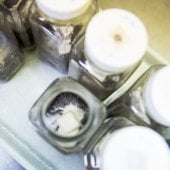
Soil Block Decay
AWPA Standard, E10, Standard Method of Testing Wood Preservatives by Laboratory Soil-Block Cultures. Also, ASTM D1413 and WDMA TM-1.
The soil block decay test is a highly standardized means for evaluating wood preservatives under tightly controlled laboratory conditions, including control over the type and number of decay fungus species to which the specimens are exposed. Small wood blocks are dried, weighed and inoculated with decay fungi in a jar containing sterilized soil, which is then maintained at approximately 80°F (27°C) and 80% RH. After a specified time period (usually 12 weeks), the soil block specimens are removed, dried and weighed to determine weight loss due to decay.
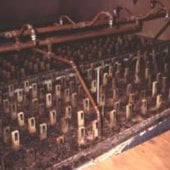
Soil Bed Decay
AWPA Standard, E14 -Standard Method Of Evaluating Wood Preservatives In A Soil Bed.
Soil bed stake decay testing is an effective means for relatively quickly evaluating the efficacy of wood preservatives in wood under severe ground contact conditions. Wood foundations, utility poles, building poles, and land or fresh water pilings may undergo similar, if less severe exposures. Treated (and untreated) wood stakes are inserted half-way into the soil bed. At specified time intervals the stakes are removed and rated for severity of decay and insect damage. They are placed back into the soil bed after each rating until a light bending force causes them to fail.
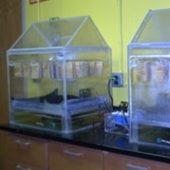
Mold Resistance on Wood Surfaces
AWPA E24 Standard Method of Evaluating the Resistance of Wood Product Surfaces to Mold Growth. or MTU Developed Test Method
This test evaluates the resistance or susceptibility of wood-based materials to surface mold-stain fungi. Test samples are suspended above pre-inoculated soil in a sealed chamber. The soil is above 3 inches of warm water, which keeps the air temperature at 25 degrees C and the relative humidity at 90-100%. Specimens are inoculated with mold fungi. Samples are suspended in the chamber and rated weekly for a total of 8-16 weeks.
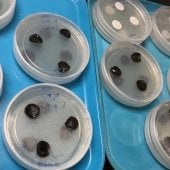
Mold Resistance to Wood Adhesives
ASTM Standard D 4300. Standard Test Methods for Ability of Adhesive Films to Support or Resist the Growth of Fungi.
This test evaluates the ability of adhesive films on agar plates to inhibit or support the growth of selected mold fungus species. The test provides means of testing adhesive films of various solubility and viscosity on two agar substrates, one which promotes microbial growth and one which does not. Agar plates with adhesive disks are inoculated and evaluated weekly for up to three weeks. The standard has been approved for use by agencies of the Department of Defense.
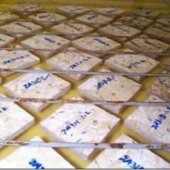
Thickness Swell and Water Absorption
Modified ASTM Standards, D 1037 - Standard Methods Of Evaluating the Properties of Wood-Base Fiber and Particle Panel Material, 1989, pp. 167-196.
Water absorption and thickness swell of wood products due to contact with water is
a large problem in the construction industry. High wood moisture content increases
the susceptibility of the wood to decay and insect damage, and may cause other undesirable
physical and mechanical effects. Thickness swell is especially undesirable in construction
applications where dimensional stability is required. To reduce, or slow down the
absorption of water in wood composites a hydrophobe (water repellent) is added during
its manufacture. This test is intended to test the effectiveness of the hydrophobe
as well as the overall dimensional stability of the wood composite when submerged
in water.
Specimens are measured, weighed and placed under a grid one-inch below the water-line
in a water bath maintained at approximately 64°F (18°C). After two hours and 24 hours
the specimens are removed from the water, weighed, and the thickness is measured.
The percent change from the original thickness represents the thickness swell, and
the percent weight change from the original weight represents the water absorption.
Specimens are reconditioned to equilibrium moisture content and measured again to
determine the non-recoverable thickness swell.
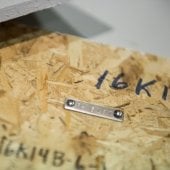
Specific Gravity, Density, and Moisture Content
ASTM Standard: D 2395 Standard Test Methods for Specific Gravity of Wood and Wood-Base Materials.
Specific gravity and moisture content are two factors having a great affect on the physical and mechanical properties of wood. As such, these variables must always be considered when wood is tested, or used to evaluate the efficacy of an experimental preservative. Wood selection for preservative testing is often determined by the number of growth rings per inch, or by a specific weight range to minimize specific gravity (and density) as a variable. Moisture content is also controlled, either by oven-drying the specimens, or by conditioning them in a climate-controlled room for a specified period of time.
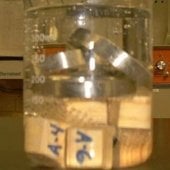
Leachability
AWPA Standard, E10, Standard Method of Testing Wood Preservatives by Laboratory Soil-Block Cultures. 11.2 Leaching Procedures for Water-borne Preservatives, 1999. or AWPA Standard, E11, Standard Method of Determining the leachability of Wood Preservatives, 1999.
Leachability testing is a type of accelerated laboratory depletion test. It evaluates the degree of fixation of the preservative under the harshest conditions. Leachability specimens are saturated with distilled water under pressure and kept submerged with weights. The water is changed at specified time intervals for two weeks. The changed water (leachate) may be saved for analysis. After the leaching period is over the specimens are analyzed along with unleached specimens to determine the amount of preservative leached out of the specimens.
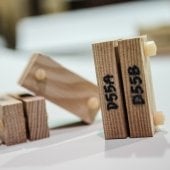
Corrosivity of Metal in Contact with Treated Wood
AWPA, E12-94 -Standard Method Of Determining Corrosion Of Metal In Contact With Treated Wood, 1996. p.318.
With the wide variety and extensive use of metal fasteners in wood construction, determining the effect of preservative chemicals on metal corrosion rates is important. Test metal strips, commonly including SAE 1010 steel, red brass, aluminum alloy, and hot-dipped zinc galvanized steel are sandwiched between treated wood blocks. The assemblies are held together with nylon fasteners under moderately high temperature and high humidity for a specified time period. Then, the corrosion products are cleaned from the metal specimens, and the weight loss due to corrosion is determined. Using a standardized formula, the corrosion rate is expressed in mils per year.
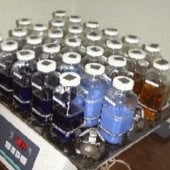
Corrosivity of Metal in Treating Solution
AWPA Standard, E17 Standard Method For Determining Corrosion Rates Of Metals In Contact With Treating Solutions, 1999, pp.404-405.
This test is relevant to wood preservers who may use the chemicals to treat wood in assessing the potentially damaging corrosive effect on their plant equipment. Test metal alloy coupons, commonly including mild steel, red brass, and phosphorous bronze are suspended in jars of treating solution by strings attached to the jar lids. The assembled test jars are agitated on a platform shaker for 25 days, with the treating solution changed at specified time intervals. After 25 days the corrosion products are cleaned from the metal test coupons, which are then weighed to determine the weight loss due to corrosion. Using a standardized formula, the corrosion rate is expressed in mils per year.
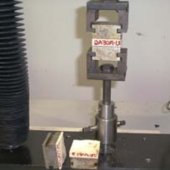
Mechanical: Internal Bond
Annual Book of ASTM Standards, 1989, D 1037 -Standard Methods Of Evaluating the Properties of Wood-Base Fiber and Particle Panel Material, pp. 167-196.
Internal bond is a fundamental measure of the adhesive performance in wood composites. This strength is in large part determined by the effectiveness of the glue application in the composite manufacture, but is also affected by other variables such as wood particle size and density of the composite. The internal bond specimen size is 2x2 inches (50x50 mm) by the composite thickness. Aluminum test blocks are glued to the top and bottom surfaces of the specimen using hot-melt glue. The test machine fixture grips the aluminum blocks and applies tension perpendicular to the specimen surface until the specimen fails. Internal bond is then reported as the maximum recorded load divided by the cross sectional area of the specimen.
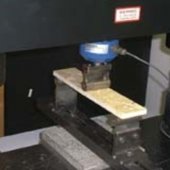
Mechanical: Static Bending
Annual Book of ASTM Standards, 1989, D 1037 -Standard Methods Of Evaluating the Properties of Wood-Base Fiber and Particle Panel Material, pp. 167-196. or D 143 Part II. Secondary Methods or D 790M, Standard Test Methods for Flexural Properties of Un-reinforced and Reinforced Plastics and Electrical Insulating Materials [Metric], pp. 290-297.
Static bending refers to tests performed in which a bending stress is applied to the specimen to determine the stiffness, or modulus of elasticity of the specimen as well as the amount of force required to cause the specimen to fail, expressed as the modulus of rupture. The specimen size is dependent on the testing standard used, the material type, the original size and intended end-use of the material being tested.
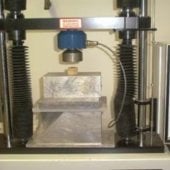
Mechanical: Compression Testing
Based on the method of Nicholas (Dr. Darrel D. Nicholas, Dr. Zhongwei Jin. 1996. Use of Compression Strength Loss For Measuring Decay in the Soil Block Test.IRG/WP 96-20083)
This test was designed to provide compressive strength data for small-sized wood specimens, since the larger size specimens required for the standard ASTM test method cannot always be obtained. One inch cube specimens are conditioning to 12% MC. Then, the specimen is positioned under the test machine compression plate for an applied load perpendicular to the tangential face of the specimen. The specimen is preloaded to 10 lbs, and then compressed until 5% strain is achieved. The load at 5% strain is recorded.